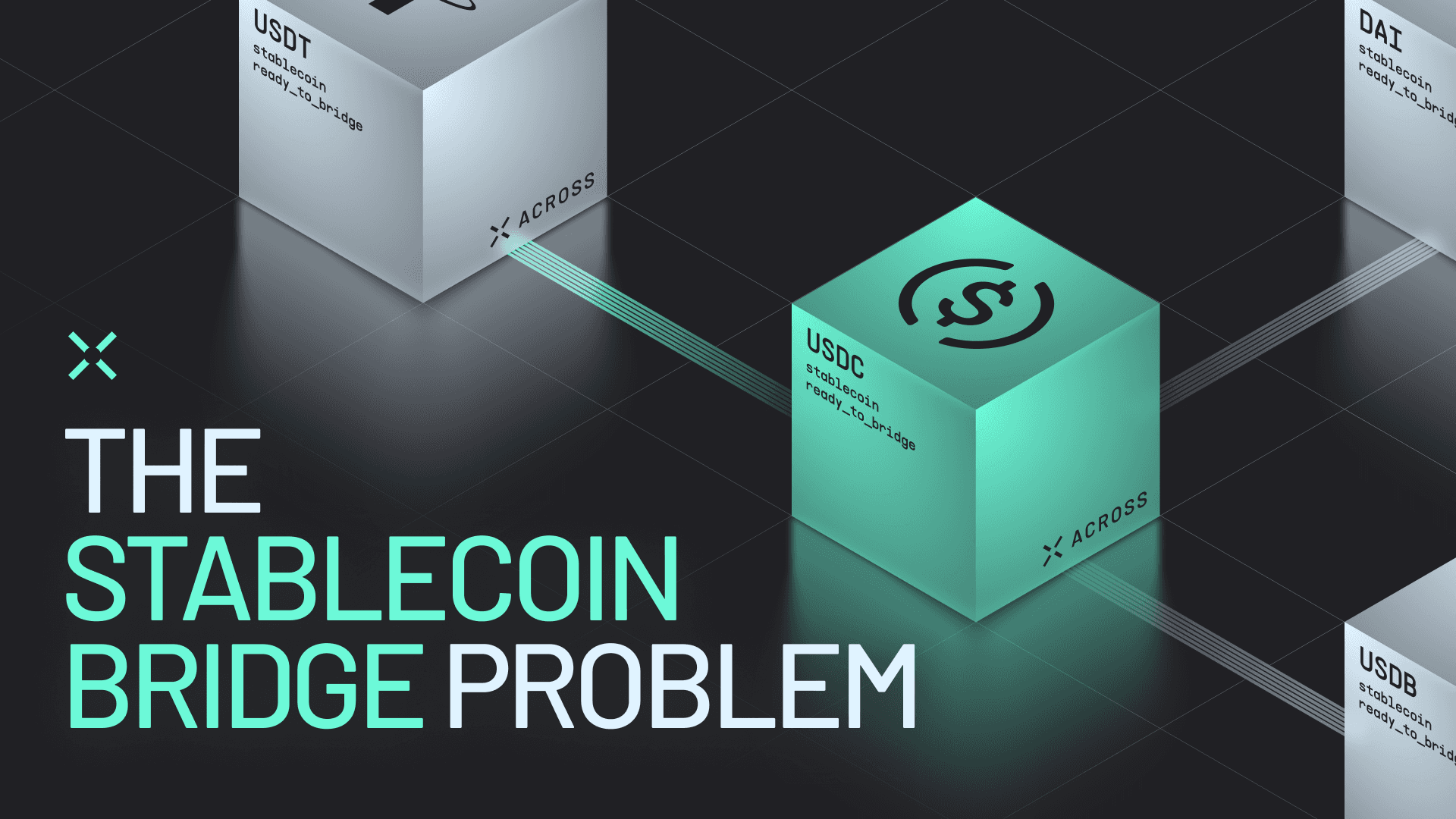TL;DR
Stablecoins now settle over $46 trillion annually and power more than half of all onchain volume, yet bridging them remains fragmented. This post explores the stablecoin bridge problem, why interoperability matters, and how Across unifies crosschain movement with speed, cost efficiency, and security.
Introduction
Stablecoins are the new power players in crypto. They settle trillions in value, ride on every major chain, and serve everyone from remittance senders to corporate treasuries. Yet the moment you try to move a stablecoin across chains, things get confusing. Different token contracts, wrapped variants, odd fees, security worries, and inconsistent experiences.
In a multichain world, the stablecoin bridge experience still feels like switching airports mid-flight. In this blog post, we break down the stablecoin landscape, explain the interoperability problem, and explore how the stablecoins are evolving toward a unified, seamless experience that finally makes money feel effortless.
The Global Stablecoin Landscape in 2025
Stablecoins used to be a niche topic. Today, they are the backbone of digital value transfer, powering everything from DeFi markets to real-world payments.
In the past year alone, stablecoin settlement volumes exceding $27 trillion, surpassing the combined annual volume of PayPal, Visa, and Mastercard. They’re now the primary settlement layer for crypto with the wider digital economy on its way.
Let’s look at how these tokens work, who issues them, and where they live.
Stablecoins Dominate Onchain Activity
Over 30% of all crypto transactions involve stablecoins. More than $300 billion are in circulation across major networks as of Q4 2025, with daily transfers exceeding $100 billion. They work like digital dollars: instant, global, and low-cost.
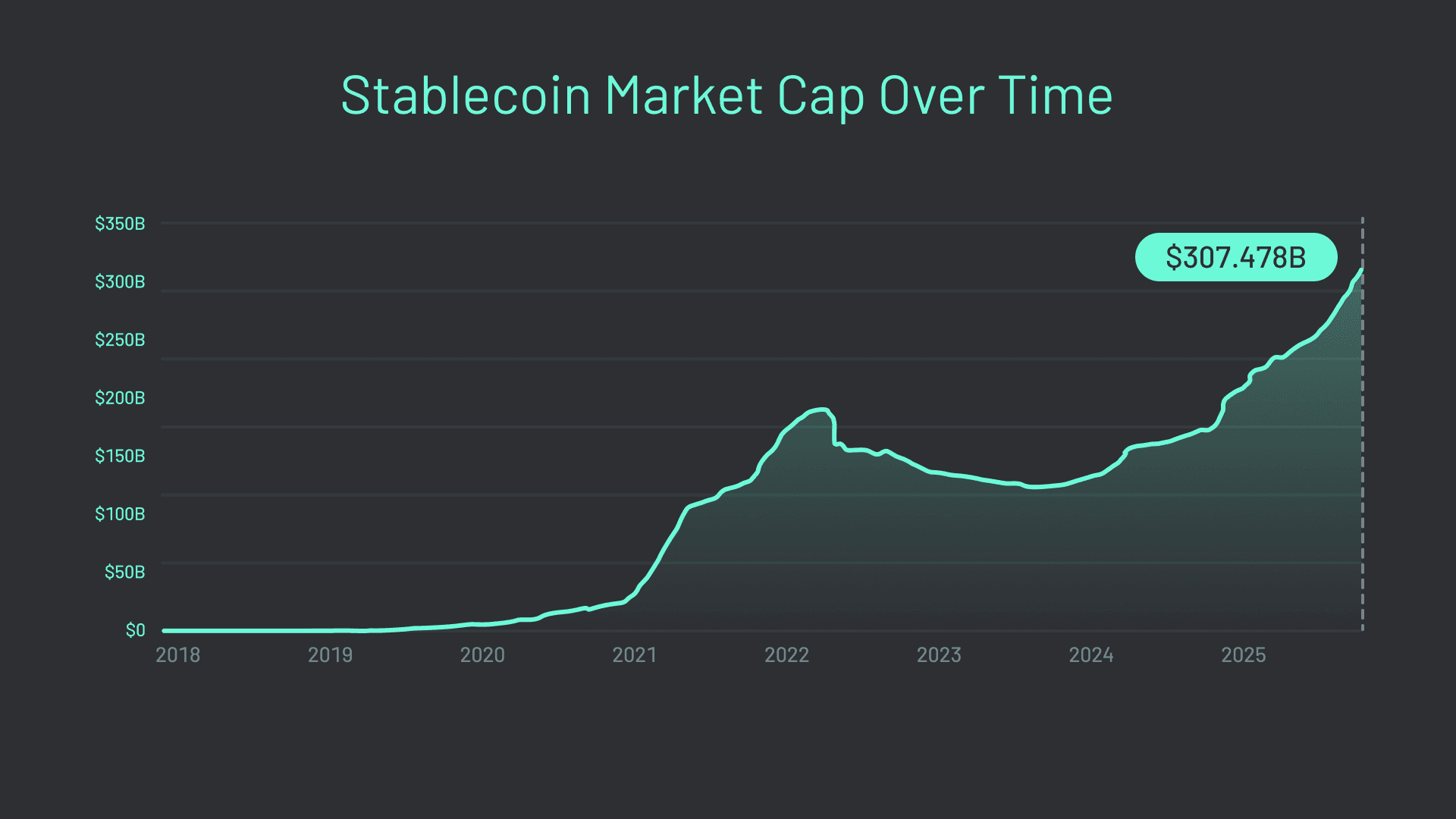
Stablecoin Market Cap has steadily grown over the past few years.
Who Issues What, and How the Peg Works
The market is still dominated by two issuers that together account for over 75% of all stablecoins in circulation:
Tether (USDT): over $165 billion in circulation across eight chains, backed primarily by U.S. Treasury bills and short-term securities.
Circle (USDC): roughly $65 billion in circulation across 15+ chains, fully backed by cash reserves and U.S. Treasuries held with regulated custodians.
Decentralized alternatives like Maker’s USDS (formerly DAI) and Ethena’s USDe are growing fast, with $5–10 billion each in circulation. Many more continue to come to market as well. Together, stablecoins now represent roughly one-third of all crypto market liquidity.
Meanwhile, regulation is catching up. Clearer reserve standards and mandatory disclosures are improving trust, while frameworks such as MiCA in Europe and the GENIUS Act in the U.S. define what counts as a compliant payment stablecoin.
Real-World Value, Not Just DeFi
Stablecoins have moved far beyond trading pairs and DeFi yield farms. They’re now used globally for savings, payments, and commerce.
According to a16z’s State of Crypto 2025 report, stablecoins now account for more than 50% of all onchain transaction volume, with monthly transfers exceeding $1.6 trillion. This is a six-fold increase since 2020.
Most stablecoin transaction volume originates from institutional and corporate activity. Reports from a16z and The Block show that large transfers between exchanges, treasuries, and market makers account for the majority of stablecoin value moved onchain, while Circle and Visa highlight growing use in corporate treasury management and after-hours settlement. Additionally, stablecoins serve as digital lifelines in emerging markets.
Here are examples of how stablecoins serve tangible human and business needs:
In countries like Argentina and Nigeria, they make up over 40% of crypto transaction volume, serving as digital lifelines in inflationary economies.
For remittances, fees have dropped from roughly 6% to under 2%, saving billions for migrant workers each year (World Bank 2025 Report).
Institutional adoption is accelerating. a16z notes that nearly half of surveyed organizations exploring blockchain payments are using stablecoins to reduce settlement costs and improve global liquidity.
According to EY-Parthenon, 41% of companies using stablecoins report 10% or more cost savings on cross-border payments.
Stablecoins are quickly becoming the internet’s native form of money.
Where Stablecoins Actually Live
Stablecoins are spread across multiple blockchains. The majority of supply and activity is concentrated on a handful of networks, each serving a distinct type of user.
Below is a snapshot of the largest chains by circulating stablecoin supply as of late 2025:
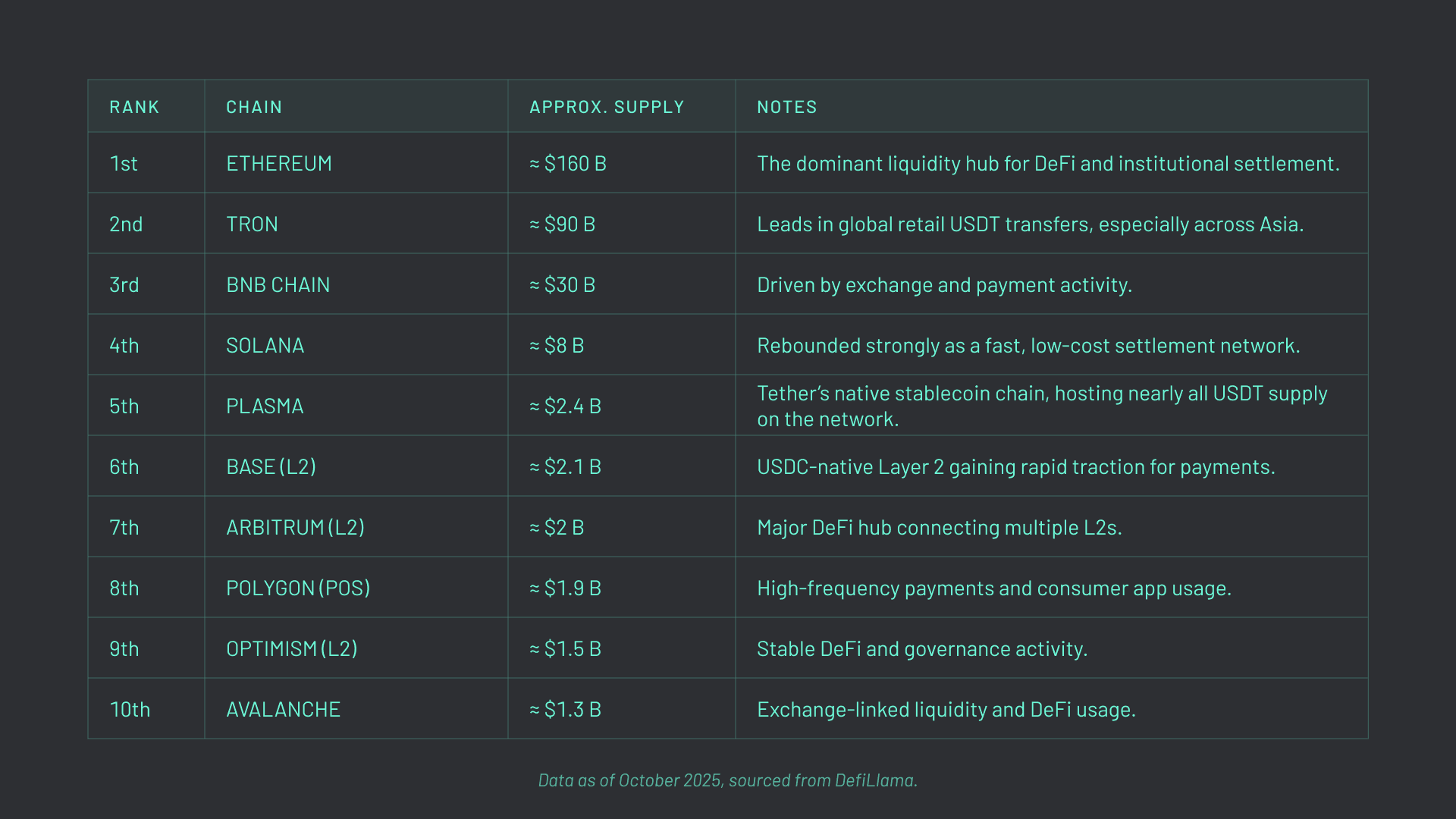
Stablecoin supply and activity on different chains.
(All values approximate; sourced from DefiLlama Stablecoins by Chain, October 2025.)
Key Observations:
Ethereum still anchors liquidity, with more than half of all stablecoin supply on mainnet and its Layer 2s.
TRON continues to dominate transaction count through global USDT retail usage.
Plasma, Tether’s purpose-built stablecoin chain, has already climbed to #5 overall, hosting over $2 billion in supply only months after launch, serving as proof of how rapidly issuer-native networks can scale.
Solana has regained momentum after its 2023 slump, emerging as a fast, low-fee stablecoin settlement chain.
BNB Chain and Polygon remain core payment rails for retail users, while Base, Arbitrum, and Optimism lead Layer 2 adoption.
Stablecoin liquidity is more distributed than ever, but also increasingly fragmented. Each of these networks hosts different versions of the same assets, creating interoperability challenges at both the user and protocol level. This fragmentation is precisely where the interoperability problem begins.
The Stablecoin Bridge Problem: Why Interoperability Matters
Moving stablecoins across chains shouldn’t feel complicated, yet it does. Each network hosts its own version of the same asset, with separate liquidity pools, fees, and risks. This fragmentation breaks composability and forces users and developers to juggle multiple bridges, tokens, and trust assumptions.
The Fragmentation Dilemma
Instead of one unified stablecoin economy, we have dozens of isolated ones. USDT on Tron isn’t the same as USDT on Ethereum. USDC on Base differs from USDC on Arbitrum. That duplication splits liquidity and limits how capital can move freely across the ecosystem. Composability becomes a nightmare, and you must trust various intermediaries to move funds safely.
Stablecoin fragmentation results in painful user experiences:
You struggle with extra steps, risky bridges, and unfamiliar token symbols.
Developers lose composability and have to manage liquidity across isolated ecosystems.
Businesses find it hard to unify treasuries and forecast crosschain costs.
Low-quality UX is unacceptable. Interoperability is the way forward.
Interoperability is the Unlock
When stablecoins can move freely across chains as a single, unified asset, the ecosystem begins to behave like one economy. Interoperability simplifies your experience, strengthens security, and enables seamless global liquidity that benefits everyone.
What Is a Stablecoin Bridge?
A stablecoin bridge is the infrastructure that lets you transfer tokens between blockchains. Early solutions made this possible but at the cost of complexity and risk. Here’s how each model works and why the industry is evolving beyond them.
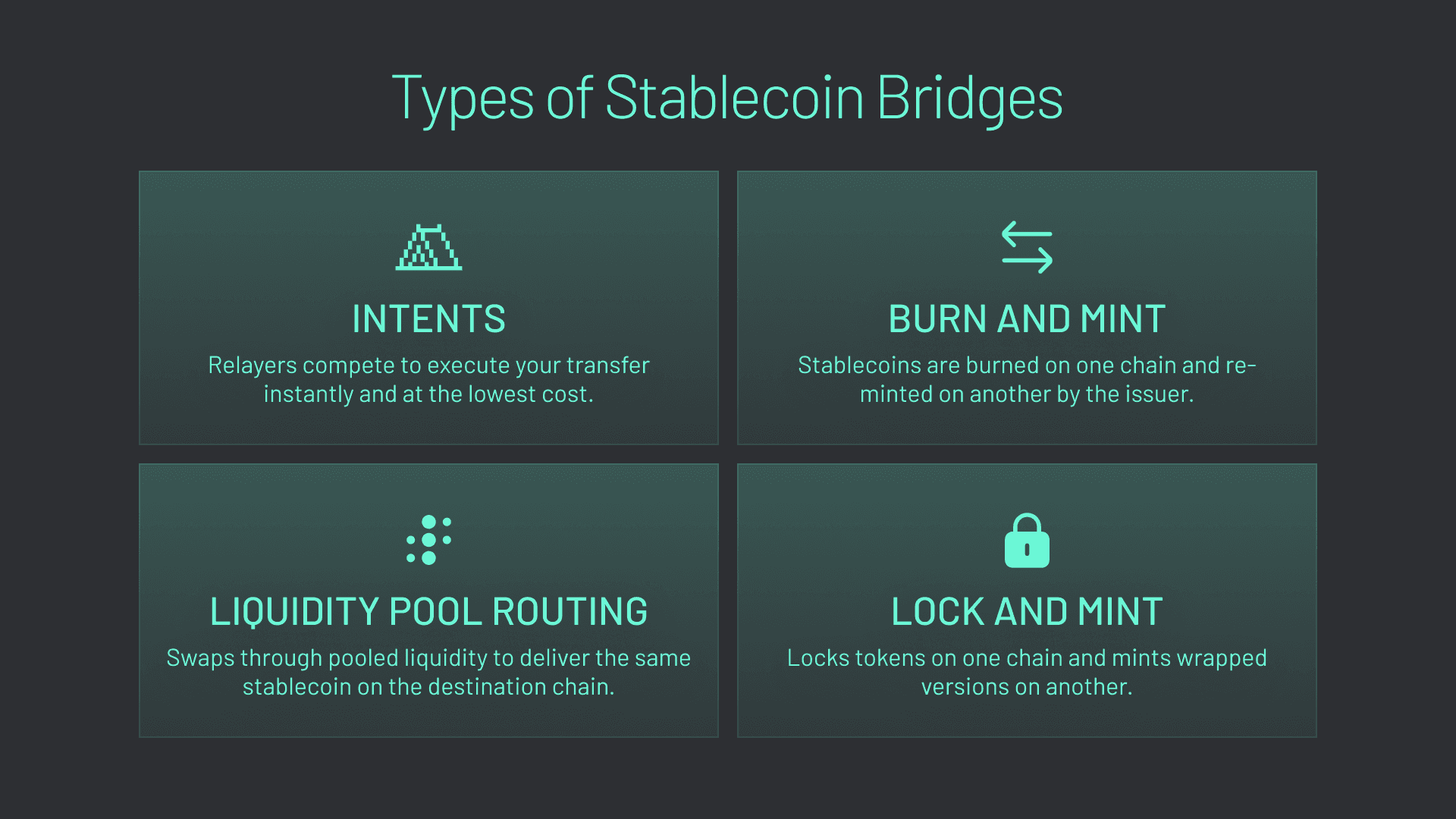
There are four main types of stablecoin bridges: intent-based, burn and mint, liquidity pool routing, and lock and mint.
1) Intents
The fastest, most cost-efficient way to bridge stablecoins. Intent-based bridges use third-party relayer networks that compete to execute crosschain transfers as quickly and cheaply as possible on behalf of users.
Pros: Fast, cheap, and zero finality risk for users.
Cons: Can struggle with very large transactions.
2) Burn and Mint, Natively
A newer and cleaner model than Lock and Mint. Your stablecoin is burned on the source chain and minted on the destination chain by the official issuer.
Pros: Unified supply, higher capital efficiency, and fewer trust assumptions.
Cons: Requires issuer support and crosschain attestation networks.
3) Liquidity Pool Routing
You swap stablecoins on the source chain into a pool that pays out the same brand of stablecoin on the destination chain.
Pros: You receive a native asset on the destination chain.
Cons: Requires deep liquidity, introduces slippage, and ties up capital in idle pools.
4) Lock and Mint
You deposit stablecoins on the source chain, and the bridge mints a wrapped version on the destination chain.
Pros: Quick to launch, chain-agnostic.
Cons: Creates wrapped tokens that fragment liquidity and add custodial risk. Many high-profile exploits targeted these locked pools.
Each type of bridge provides a simple, native experience that hides the complexity of multiple blockchains.
The Evolution of Stablecoin Bridges: Toward Unified Liquidity
Bridging technology has evolved through several major stages. Each step solved one part of the problem, but none delivered a fully unified experience… Until intents came along.
From Wrapped Assets to Native Issuance
Early bridges used lock-and-mint or pool-based models, which introduced wrapped tokens and liquidity silos. Native burn-and-mint protocols like Circle’s CCTP and Maker’s USDS with Wormhole NTT fixed that at the asset level. They allow stablecoins to move as a single, canonical token across chains, burning on one side, mint on the other.
This was a major leap forward for security and capital efficiency, but it didn’t fully solve the end-user experience. Native bridges handle the technical movement of value, not the decision-making around how to move it, when, and by which route.
The Next Layer: Intents as the Coordination Solution
This is where intent-based systems step in. Intents describe what the user wants to achieve, leaving it to the network to determine how to achieve it best. Instead of manually selecting a bridge or comparing routes, you simply declare an intent — like “send USDC from Arbitrum to Base” — and the system handles execution through the most efficient native bridge or swap path available.
In this model, native bridges become inputs, and intent layers become the orchestrator. Together, they turn a once-fragmented ecosystem into something that feels like one unified network.
Why This Matters
Native bridging protocols unify liquidity at the asset layer. Intent-based systems unify it at the experience layer. Together, they form the logical endgame for crosschain movement: secure, capital-efficient, and invisible to you as the user.
Across Protocol: The Interoperability Layer for Stablecoin Movement
This is exactly where Across Protocol comes in. Across delivers on the promise of true interoperability by abstracting away every layer of friction so you can effortlessly move stablecoins across chains. You don’t need to think about bridge routes, token variants, or settlement times. Across turns crosschain transfers into a single seamless action that's fast, cheap, and secure.
But before we look at how that works, let’s recall the pain points described earlier: slow and clunky processes, security risks, confusing token versions, and fragmented liquidity management. Across eliminates all of these.
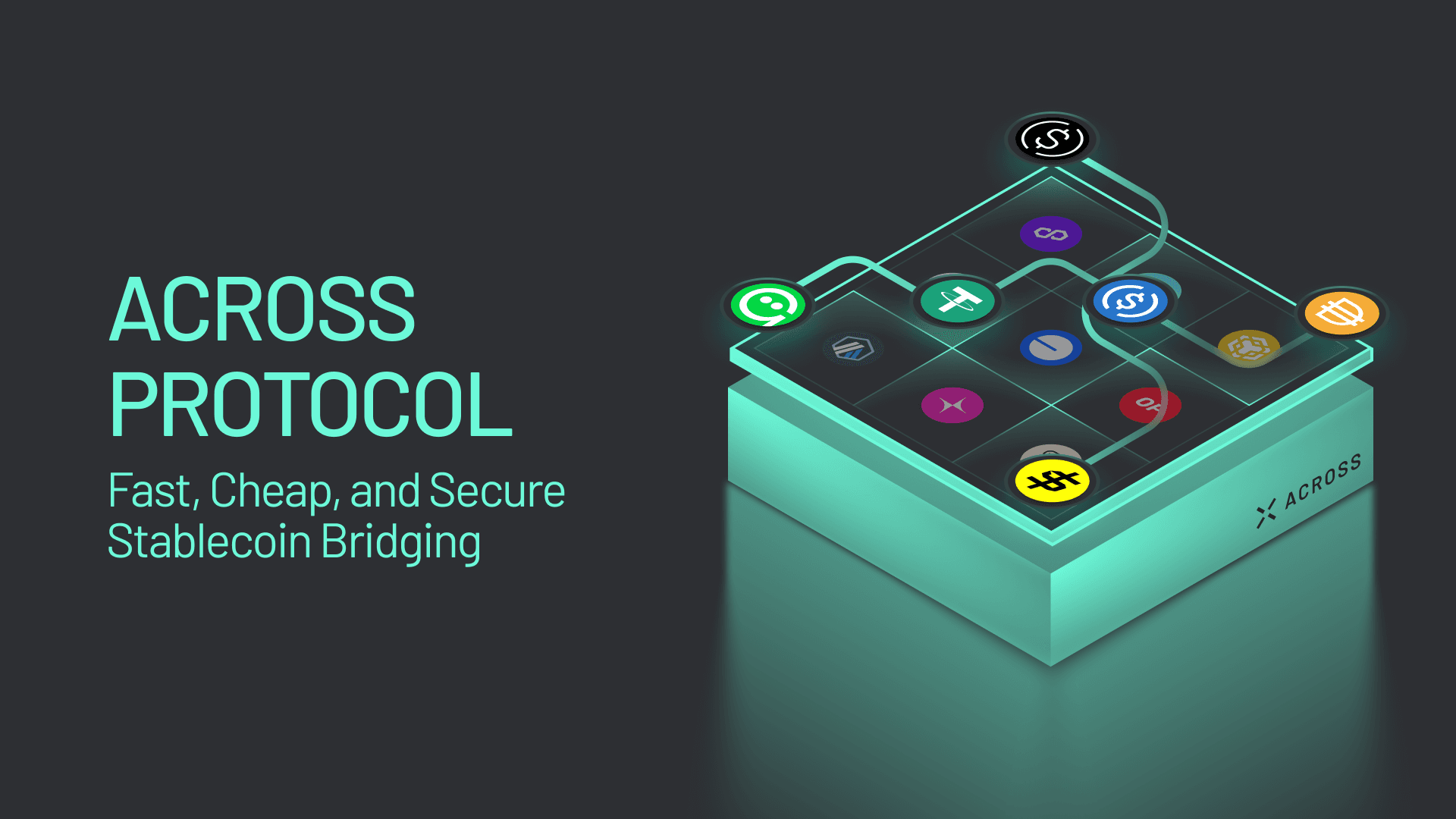
Across Protocol provides fast, cheap, and secure stablecoin bridging across chains.
Intent-Based, Infrastructure Aware
Across Protocol is the pioneer of crosschain intents. Its system interprets what you want to do, not just where you want to send funds. It determines the optimal route, timing, and method, using native bridges such as CCTP for larger transactions. The heavy lifting happens under the hood, so you simply get to enjoy your stablecoins wherever you want them.
Fast and Seamless Stablecoin Bridge
With Across, bridging stablecoins feels instant and effortless. Transfers settle in seconds, cost cents, and arrive securely without the delays or risks common in other systems. You don’t have to think about routes, relayers, or bridge selection. Across abstracts away the complexity so moving stablecoins across chains feels as seamless as sending them on a single network.
Built for Developers and Businesses
As a developer, you can integrate Across to power native stablecoin bridging and crosschain actions within your application. This unlocks opportunities to reach and serve new users and liquidity across all the chains that Across supports.
Access a single interface that adapts as new native bridge routes emerge.
Gain predictable crosschain operations without manually managing liquidity.
Enjoy a consistent experience that hides the plumbing and surfaces only the outcomes for your users.
Across provides the coordination layer that makes stablecoin interoperability practical and invisible.
The Future of Stablecoin Movement Is Unified
Stablecoins proved that programmable dollars can operate at global scale. The next leap is making them move as freely as they exist. Native burn-and-mint protocols are fixing the technical foundation, while intent-based interoperability layers like Across deliver the experience that makes it feel seamless.
When you move money, you shouldn’t have to think about bridges. You should just see the results. That’s where the stablecoin ecosystem is heading, and that’s the reality Across is building toward.
Join the Across community:

